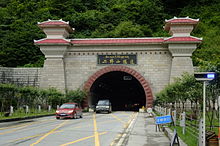 The tunnel in 2010. | |
| Overview | |
|---|---|
| Route | China National Highway 318 |
| Operation | |
| Opened | December 8, 1999 2018 |
| Technical | |
| Length | 13,433 metres (44,071.5 ft) |
| No. of lanes | 2 |

The Mount Erlang Tunnel is a road tunnel along the Sichuan-Tibet Highway (China National Highway 318), which connects Ya'an and Garzê Tibetan Autonomous Prefecture in Sichuan Province, China. The tunnel is 4,176 meters long and was dug through Mount Erlang in Sichuan Province. [1]
Contents
It opened on December 8, 1999. Construction took three years and cost 470 million yuan (56.6 million US dollars).
It was built to reduce time and replaces one of the most dangerous parts of the highway, which had frequent accidents because of landslides, rain and foggy weather. [1]